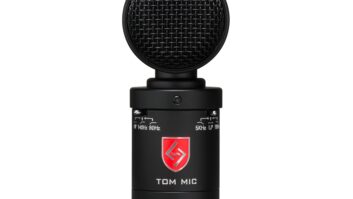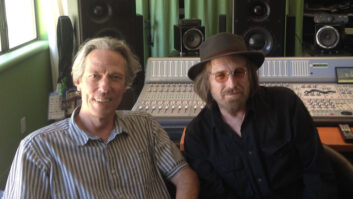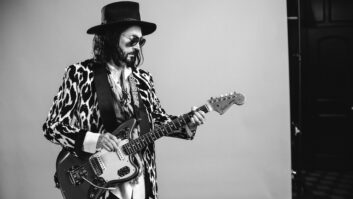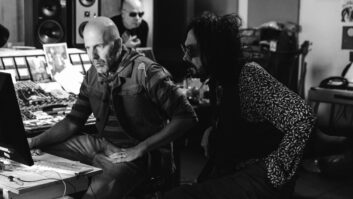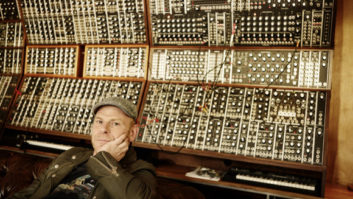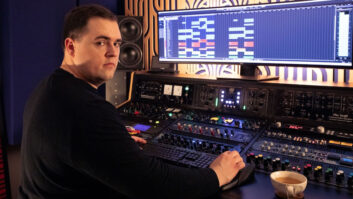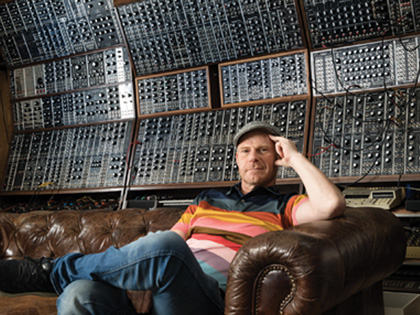
Tom Holkenborg, aka Junkie XL, music is sound and sound is music. “Here, listen to this,” he says, sit- ting at his workstation at his home studio in Tarzana, surrounded by synthesizers, young and old—including two large wall racks making upa pair of modular synth systems.
“Thatbecamethis,” heexplains, playinga singledistorted guitarnotehe recordedearlier in the day,sitting on the couch behind him
withaguitarandamp, followedbyanunusual,
yet curiously melodic, set ofbee-like sounds that healsocreated forhislibraryandscoring template. Synths and audio gear are every- where.There’sevenarackofamplifiersinthe bathroom…justincase.
Ina nearby room, assistant Aljoscha Christenhuß concentratesquietly at his own rig,creatingnewsoundsashehasbeen forthe pasttwo years.Bothhisandhismentor’swork willone dayfindtheir wayinto afilmscore, whenthetimeisright.Andboth represent the Tom Holkenborg in front ofthe modularsynth wall inhis home studio.
two key componentsto Holkenborg’s legacy: creatingnew musicallandscapesandteaching otherstodothesame.
The Dutch-born multi-instrumentalist was already at the top of his game as an electronic artist when he came to the U.S. in the early 2000s to make the shift to film scoring. “I was always fas- cinated by films,” he tellsMix. “I was doing well in the electronic scene, and my albums were always concept albums, traveling through all these different atmospheres.” But after hearing his 1997 hit “Dealing With the Roster” from his first album, Saturday Teenage Kick, used in a fight scene in Wesley Snipes’ Blade, he became intrigued. “I was so blown away at how it worked. I wanted to know more.”
Holkenborg has always been surrounded by music, with a mother who taught theory to young kids, and also, like his father, played numerous instruments.
“We would always make music together in the house,” he recalls. He got his first toddler drum kit at age four, becoming proficient in drums, guitar and bass by 13, and working in a music store selling—what else—synthesizers at 16. His mother imparted something else, though, which had an impact.
“She also taught classes at night for kids who came from more unfortunate families that didn’t make that much money. One-on-one lessons, even in the ’70s, were still a fairly expensive thing. I never forgot that.”
Electronics were always around, too, Holkenborg making his own printed circuit boards and building his own amplifiers and pedals from childhood. While still a teenager, he volunteered at a radio station, assisting with engineering.
After becoming enamored of the likes of Trevor Horn as a teenager, as well as Steely Dan, Quincy Jones, The Who and Pink Floyd, Holkenborg began recording himself. “When I was really young, those were all super-inspirational to me—records that were really well-produced. The way those records were put together was like ear candy to me. But then I started to appreciate bands with shitty production, but had fantastic music. Because that sound, very low-fi, became a tool of its own.”
For his first “multitrack” recordings, at age 13, he used a pair of cassette players and a mixer he had built himself. The results were noisy from ping-ponging back and forth, but like many young players of the time, he eventually got a Tascam 4-track cassette PortaStudio, recording with a DX7, a Rev 5 and a DMX drum computer (“plus a lot of guitars”). He landed at a local studio, assisting and then producing, with access to an Ampex 24-track tape machine and a DDA Profile mixer with Neve EQs, which he later bought. “That’s when I really started to learn to engineer and record,” he says. “And it’s something kids miss out on today because you had to learn to quickly set up a mix from scratch. That’s when you become a really good engineer.”
After several years of making records, he was invited in 2000 by Jason Bentley, music supervisor on The Matrix Reloaded, to come to America to create the title song for that film with Depeche Mode’s Dave Gahan. Though the track went unused, Bentley suggested he move permanently to L.A. “He said, ‘If you’re here, then you can start building your career as a composer. You can’t do that from Amsterdam,’” Holkenborg recalls.
He made the move, and began meeting with studios (e.g., Warner Bros., which gave him a 15-second cue to do for The Scooby-Doo Movie) and, more importantly, composers. “I realized there was a long road ahead,” he notes. In 2002, Harry Gregson-Williams invited Holkenborg to work with him at his studio in Venice, Calif. “I knew immediately, ‘Wow, I need to learn a lot. This is not gonna be easy.’ So I just decided to take a back seat in the bus and see how other people worked, and do tiny jobs. There I was,down in the cellar, chopping up audio files, while at the same time, I had a Number One hit worldwide in 24 countries [a remix of Elvis’ “A Little Less Conversation”]. But I was willing to start from the ground up.”
Besides creating loops, Holkenborg learned plenty just by watching Gregson-Williams at work, and after a couple of movies there, he began getting scoring jobs himself. In 2011, Hans Zimmer offered to make him part of the Remote Control fold in Santa Monica.
“I really knew what I wanted to do with film scoring by then,” Holkenborg recalls. “Hans said, ‘Okay, what you need is two years of good monitoring and just seeing what I do, and then you’re ready to go.’ But it wasn’t so much things on the music level; I had that down. It was that last 10 percent that I really needed to learn—how to deal with the politics with a studio and how to deal with a director. That’s what he showed me, because these big movies, which Hans and I worked together on, were the NFL, the big leagues.” It didn’t hurt that the two had a love of electronica in common. “We’re both nerds,” Holkenborg laughs. “I can send him a picture of a synthesizer at 1 a.m., and then, within 10 minutes, he’s sending me something back.”
The two worked together until 2013, Holkenborg helping out with certain cues for Zack Snyder’s Man of Steel. The director had such a strong connection with Holkenborg that, when things didn’t work out with the original composer for his 300: Rise of an Empire, he asked him to take the reins—and create a new score in 23 days. Since then, with the exception of last year’s Batman v Superman, for which he and Zimmer shared composing duties, he has been on his own.
SCORING BIG
While he only had a scant few weeks to create the score for 300, Holkenborg says the lead time a composer will have to build a score can vary from picture to picture and director to director. “If you’ve worked with the director before, the next time you come in will likely be before they even start shooting, because you’ve become friends. But when you work for the first time with a director, you can be brought in as early as five or six months before the movie is done, or as late as three or four weeks before it’s finished. Sometimes they can’t focus on finding the right composer, so they keep working with a temp score until the latest moment.”
Temp scores can be an issue, he says, particularly if they’ve been in place for a while. “If you get a film really late, everybody’s completely in love with what they’ve been hearing for months and months. When that happens, the solution is to come up with something that is so incredibly strong that people just forget about the temp score altogether. The other thing I do is make sure that when they start editing the movie, they already have a lot of music that is mine, especially written for the film, so they can start editing with that. That’s the only way to beat it.”
For some projects, he might visit the set, though for others, such as his current film Tomb Raider, he may never see any footage, just the script. He will develop themes and sketches based on the vibe of the scenes as he reads them, along with conversations he has with the director. “You have to listen to a whole story that’s being told to you by a director, and, at the same time, process all that information. And when he’s done talking, come up with a solution—right away,” he explains.
Directors may not speak the way a composer will understand it, so he has to be a good interpreter. “It’s not a visual language, like you’d expect. They speak a character language. They talk about what a char- acter is and what they’re feeling in a scene, what the emotion is. Eventually, you start to understand what the musical equivalent is of what they’re saying.”
Holkenborg won’t do what one might expect— start at the beginning of the film and work his way through. “I start from scratch, just create sketches, building a suite, from which I’ll take things out of it to craft a film score. I make long pieces of music and then send them to the director and ask, ‘Do you recognize your movie in this?’ When they say, ‘Yes,’ then I move forward. I’ll then ask the director, ‘What’s the most important scene for you?’ For a superhero movie, usually, that’s the Third Act, the final fight or something. I’ll tell him, ‘Okay, I’ll take that one on.’ I’ll work on it for a week or so, and show it to him.”
